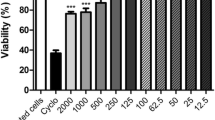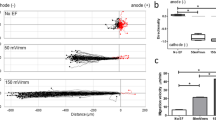Summary
Migration and tissue distribution of immunocompetent cells may be critical prerequisites for efficient immune surveillance. The effect of various concentrations of the mistletoe extract Iscador® QuFrF on the locomotory behavior and viability of immunomagnetically isolated human CD4+ and CD8+ T lymphocytes within three-dimensional collagen gels was investigated. Although variation in baseline activities of spontaneously migrating T cells was donor-dependent, a dose-dependent stimulation of the locomotory activity in both CD4+ and CD8+ T cells for noncytotoxic concentrations of Iscador QuFrF (0.25–1.25 µg/ml) was detected. The optimal concentration of mistletoe extract and time of maximal response were specific for each donor. As shown by cell tracking and subsequent data analysis, CD4+ T cells exposed to the mistletoe extract displayed a significant increase in mean velocity and time locomoting; total distance migrated was nearly doubled. In contrast, CD8+ T cells showed less pronounced changes in these critical parameters. Cytotoxic effects of the mistletoe preparation on T lymphocytes, which could at least partially be attributed to the induction of apoptosis, were drastically reduced in the presence of fetal calf serum in the culture system. Our data suggest that the direct stimulation of T-cell migration in the presence of mistletoe components may modulate in a dose-dependent manner the system of immune surveillance and recognition in patients under mistletoe therapy.
Similar content being viewed by others
References
Abe, R.; Vandenberghe, P.; Craighead, N., et al. Distinct signal transduction in mouse CD4+ and CD8+ splenic T cells after CD28 receptor ligation. J. Immunol. 154:985–997; 1995.
Blasco, E.; Barra, A.; Nicolas, M., et al. Proliferative response of human CD4+ T lymphocytes stimulated by the lectin jacalin. Eur. J. Immunol. 25:2010–2018; 1995.
Blin, N.; Stafford, D. W. A general method for isolation of high molecular weight DNA from eukaryotes. Nucleic Acids Res. 3:2303–2308; 1976.
Boyden, S. V. The chemotactic effect of mixture of antibody and antigen on polymorphonuclear leukocytes. J. Exp. Med. 115:453; 1962.
Citores, L.; Ferreras, J. M.; Iglesias, R., et al. Molecular mechanism of inhibition of mammalian protein synthesis by some four-chain agglutinins. FEBS Lett. 329:59–62; 1993.
Friedl, P.; Noble, P. B.; Zänker, K. S. Lymphocyte locomotion in three-dimensional collagen gels. Comparison of three quantitative methods for analyzing cell trajectories. J. Immunol. Methods 165:157–165; 1993.
Friedl, P.; Noble, P. B.; Shields, E. D., et al. Locomotor phenotypes of unstimulated CD45RAhigh and CD45ROhigh CD4+ and CD8+ lymphocytes in three-dimensional collagen lattices. Immunology 82:617–624; 1994.
Gabius, H.-J.; Gabius, S. Wohin führt die naturwissenschaftliche Forschung über Misteltherapie? Dtsch. Ärztebl. 91:1511–1515; 1994.
Hajto, T. Immunomodulatory effects of Iscador: a Viscum album preparation. Oncology 43 (suppl. 1):51–65; 1986.
Hajto, T.; Hostanska, K.; Frei, K., et al. Increased secretion of tumor necrosis factor α, interleukin 1, and interleukin-6 by human mononuclear cells exposed to β-galactoside-specific lectin from clinically applied mistletoe extract. Cancer Res. 50:3322–3326; 1990.
Hajto, T.; Hostanska, K.; Gabius, H.-J. Modulatory potency of the β-galactoside-specific lectin from mistletoe extract (Iscador) on the host defense system in vivo in rabbits and patients. Cancer Res. 49:4803–4808; 1989.
Holtskog, R.; Sandvig, K.; Olsnes, S. Characterization of a toxic lectin in Iscador, a mistletoe preparation with alleged cancerostatic properties. Oncology 45:172–179; 1988.
Janssen, O.; Scheffler, A.; Kabelitz, D. In vitro effects of mistletoe extracts and mistletoe lectins. Arzneim. Forsch. Drug Res. 43:1221–1227; 1993.
Jung, M. L.; Baudino, S.; Ribéreau-Gayon, G., et al. Characterization of cytotoxic proteins from mistletoe (Viscum album L.). Cancer Lett. 51:103–108; 1990.
Kissel, D. Misteltherapie. In: Wrba, H., ed. Kombinierte Tumortherapie: Grundlagen, Möglichkeiten und Grenzen adjuvanter Methoden. Stuttgart, Germany: Hippokrates Verlag; 171–175; 1990.
Kopp, J.; Körner, I.-J.; Pfüller, U., et al. Toxicity of mistletoe lectins I, II and III on normal and malignant cells. In: Van Driessche, E.; Franz, H.; Beeckmans, S., et al., ed. Lectins: biology, biochemistry, clinical biochemistry. Vol. 8. Hellerup, Denmark: Textop: 41–47; 1993.
Mossmann, T. R.; Cherwinsky, H.; Bond, M. W., et al. Two types of murine helper T cell clones. I. Definition according to profiles of lymphokine activities and secreted proteins. J. Immunol. 136:2348–2357; 1986.
Muirhead, K. A.; Wallace, P. K.; Schmitt, T. C., et al. Methological considerations for implementation of lymphocyte subset analysis in a clinical reference laboratory. Ann. NY Acad. Sci. 68:113–127; 1986.
Newman, J.; Wilkinson, P. C. Methods for phenotyping polarized and locomotor human lymphocytes J. Immunol. Methods 147:43–50; 1992.
Nikolai, G.; Friedl, P.; Noble, P. B., et al. Induction of T lymphocyte locomotion via CD2 and CD3, but not via CD3 alone. Immunobiology 194:271; 1995.
Noble, P. B.; Levine, M. D. Computer-assisted analyses of cell locomotion and chemotaxis. Boca Raton, FL: CRC Press; 1986.
Ribéreau-Gayon, G.; Jung, M.-L.; Di Scala; D., et al. Comparison of the effects of fermented and unfermented mistletoe preparations on cultured tumor cells. Oncology 43 (suppl. 1):35–41; 1986.
Romagnani, S. Human TH1 and TH2 subsets: doubts no more. Immunol. Today 12:256–257; 1991.
Salzer, G.; Hellan, J.; Babits, R., et al. Die Mistel am Ludwig-Boltzmann-Institut für klinische Onkologie. Dtsch. Z. Onkol. 3:59–63; 1987.
Springer, T. A. Traffic signals for lymphocyte recirculation and leukocyte emigration: the multistep paradigm. Cell 76:301–314; 1994.
Stettin, A.; Schultz, J. L.; Stechemesser, E., et al. Anti-mistletoe lectin antibodies are produced in patients during therapy with an aqueous mistletoe extract derived from Viscum album L. and neutralize lectin-induced cytotoxicity in vitro. Klin. Wochenschr. 68:896–900; 1990.
Author information
Authors and Affiliations
Rights and permissions
About this article
Cite this article
Nikolai, G., Friedl, P., Werner, M. et al. Effect of a mistletoe extract (Iscador® QuFrF) on viability and migratory behavior of human peripheral CD4+ and CD8+ T lymphocytes in three-dimensional collagen lattices. In Vitro Cell.Dev.Biol.-Animal 33, 710–716 (1997). https://doi.org/10.1007/s11626-997-0129-8
Received:
Accepted:
Issue Date:
DOI: https://doi.org/10.1007/s11626-997-0129-8




